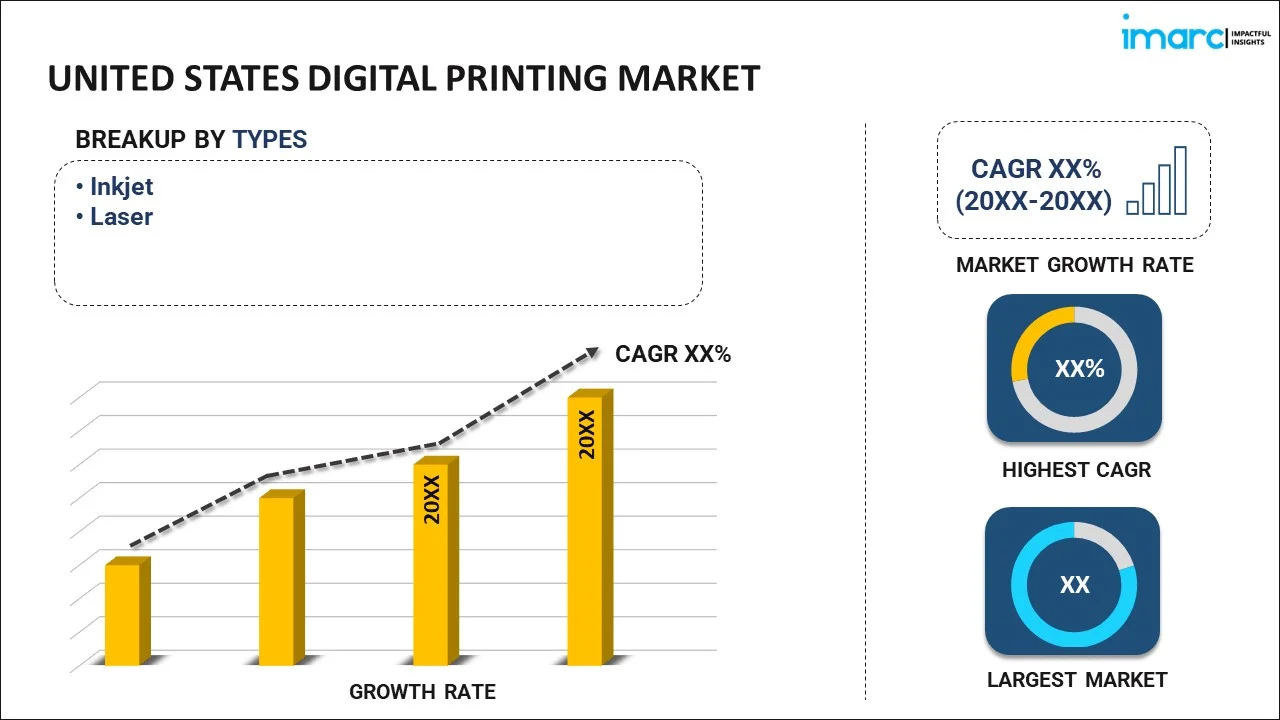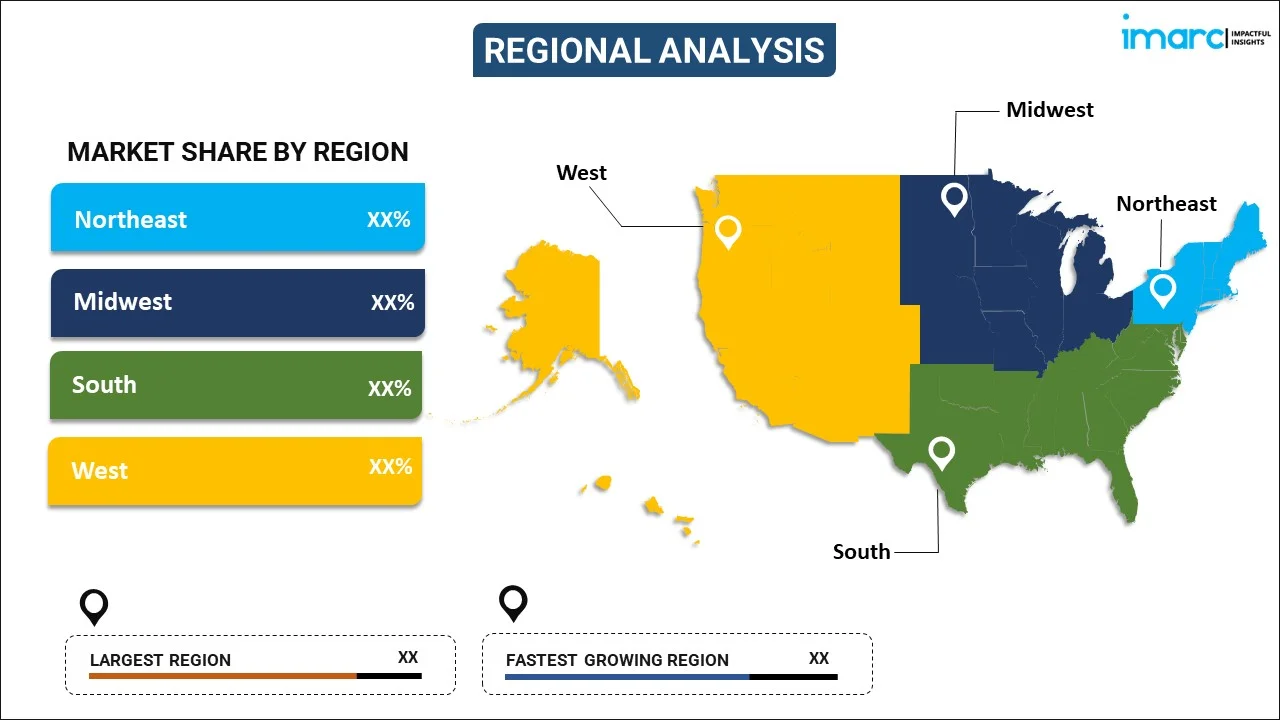
United States Digital Printing Market Report by Type (Inkjet, Laser), Ink Type (Aqueous Ink, UV-Cured Ink, Solvent Ink, Latex Ink, Dye Sublimation Ink), Application (Plastic Film or Foil, Fabric, Glass, Paper/Books, Ceramic, and Others), and Region 2025-2033
Market Overview:
United States digital printing market size is projected to exhibit a growth rate (CAGR) of 2.76% during 2025-2033. The continuous evolution of digital printing technology, growing consumer demand for personalized products, ongoing shift towards sustainable practices and escalating printing demand in fashion and industrial design represent some of the key factors driving the market.
|
Report Attribute
|
Key Statistics
|
|---|---|
|
Base Year
|
2024 |
|
Forecast Years
|
2025-2033
|
|
Historical Years
|
2019-2024
|
| Market Growth Rate (2025-2033) | 2.76% |
Digital printing refers to a modern printing method that involves the direct transfer of a digital image onto a variety of media. It uses laser or inkjet printers to print on paper, photo paper, canvas, fabric, synthetics, cardstock, and other substrates. Digital printing is comprised of several components, including digital files, printers, inks, and substrates. It finds extensive applications in advertising, publishing, textiles, packaging, direct mail, photography, architectural design, and promotional goods. Digital printing offers higher speed, lower production costs, improved quality, versatility in media, and the ability to personalize prints. In addition, it provides several advantages, such as reduced waste, eco-friendliness, faster turnaround times, consistency in print quality, and the capacity for short runs or on-demand printing.
United States Digital Printing Market Trends:
The continuous evolution of digital printing technology, such as improvements in high-speed inkjet printers and advancements in toner-based printing, is driving the market growth. Additionally, the widespread adoption of digital printing due to the growing consumer demand for personalized products like custom packaging, photobooks, and personalized marketing materials is creating a positive outlook for the market. Besides this, the ongoing shift towards sustainable practices, leading to increased use of eco-friendly inks and recyclable materials in digital printing that are appealing to environmentally conscious consumers and businesses, is boosting the market growth. Furthermore, the heightened awareness regarding the ability of digital printing to economically produce small quantities, which is particularly beneficial for small businesses and startups, is fueling the market growth. In addition, the rapid expansion of online retail, which has escalated the need for customized packaging and labeling, is contributing to the market growth. Apart from this, the rising demand for digital printing, owing to its capability to change elements, such as text and graphics, from one printed piece to the next without stopping the entire process, is catalyzing the market growth. Moreover, the escalating printing demand in fashion and industrial design for quick and cost-effective prototyping is bolstering the market growth. Along with this, the rising number of on-demand printing services, fueled by the Internet and mobile applications, is acting as another growth-inducing factor. Additionally, the incorporation of artificial intelligence (AI) and the Internet of Things (IoT) in digital printing processes to enhance efficiency and automation is favoring the market growth. Furthermore, recent advances in print quality and the durability of printed materials, which have expanded the applications of digital printing, are supporting the market growth. Besides this, rapid technological advancements, which have made digital printing cost-effective for longer runs, is positively influencing the market growth. In addition to this, the ongoing shift towards customized, on-demand printing patterns in the textile industry is providing a considerable boost to the market growth.
United States Digital Printing Market Segmentation:
IMARC Group provides an analysis of the key trends in each segment of the market, along with forecasts at the country level for 2025-2033. Our report has categorized the market based on type, ink type, and application.
Type Insights:

- Inkjet
- Laser
The report has provided a detailed breakup and analysis of the market based on the type. This includes inkjet and laser.
Ink Type Insights:
- Aqueous Ink
- UV-Cured Ink
- Solvent Ink
- Latex Ink
- Dye Sublimation Ink
A detailed breakup and analysis of the market based on the ink type have also been provided in the report. This includes aqueous ink, UV-cured ink, solvent ink, latex ink, and dye sublimation ink.
Application Insights:
- Plastic Film or Foil
- Fabric
- Glass
- Paper/Books
- Ceramic
- Others
The report has provided a detailed breakup and analysis of the market based on the application. This includes plastic film or foil, fabric, glass, paper/books, ceramic, and others.
Regional Insights:

- Northeast
- Midwest
- South
- West
The report has also provided a comprehensive analysis of all the major regional markets, which include Northeast, Midwest, South, and West.
Competitive Landscape:
The market research report has also provided a comprehensive analysis of the competitive landscape. Competitive analysis such as market structure, key player positioning, top winning strategies, competitive dashboard, and company evaluation quadrant has been covered in the report. Also, detailed profiles of all major companies have been provided.
United States Digital Printing Market Report Coverage:
| Report Features | Details |
|---|---|
| Base Year of the Analysis | 2024 |
| Historical Period | 2019-2024 |
| Forecast Period | 2025-2033 |
| Units | Million USD |
| Scope of the Report | Exploration of Historical and Forecast Trends, Industry Catalysts and Challenges, Segment-Wise Historical and Predictive Market Assessment:
|
| Types Covered | Inkjet, Laser |
| Ink Types Covered | Aqueous Ink, UV-Cured Ink, Solvent Ink, Latex Ink, Dye Sublimation Ink |
| Applications Covered | Plastic Film or Foil, Fabric, Glass, Paper/Books, Ceramic, Others |
| Regions Covered | Northeast, Midwest, South, West |
| Customization Scope | 10% Free Customization |
| Post-Sale Analyst Support | 10-12 Weeks |
| Delivery Format | PDF and Excel through Email (We can also provide the editable version of the report in PPT/Word format on special request) |
Key Questions Answered in This Report:
- How has the United States digital printing market performed so far and how will it perform in the coming years?
- What has been the impact of COVID-19 on the United States digital printing market?
- What is the breakup of the United States digital printing market on the basis of type?
- What is the breakup of the United States digital printing market on the basis of ink type?
- What is the breakup of the United States digital printing market on the basis of application?
- What are the various stages in the value chain of the United States digital printing market?
- What are the key driving factors and challenges in the United States digital printing?
- What is the structure of the United States digital printing market and who are the key players?
- What is the degree of competition in the United States digital printing market?
Key Benefits for Stakeholders:
- IMARC’s industry report offers a comprehensive quantitative analysis of various market segments, historical and current market trends, market forecasts, and dynamics of the United States digital printing market from 2019-2033.
- The research report provides the latest information on the market drivers, challenges, and opportunities in the United States digital printing market.
- Porter's five forces analysis assist stakeholders in assessing the impact of new entrants, competitive rivalry, supplier power, buyer power, and the threat of substitution. It helps stakeholders to analyze the level of competition within the United States digital printing industry and its attractiveness.
- Competitive landscape allows stakeholders to understand their competitive environment and provides an insight into the current positions of key players in the market.
Need more help?
- Speak to our experienced analysts for insights on the current market scenarios.
- Include additional segments and countries to customize the report as per your requirement.
- Gain an unparalleled competitive advantage in your domain by understanding how to utilize the report and positively impacting your operations and revenue.
- For further assistance, please connect with our analysts.
 Inquire Before Buying
Inquire Before Buying
 Speak to an Analyst
Speak to an Analyst
 Request Brochure
Request Brochure
 Request Customization
Request Customization




.webp)




.webp)












